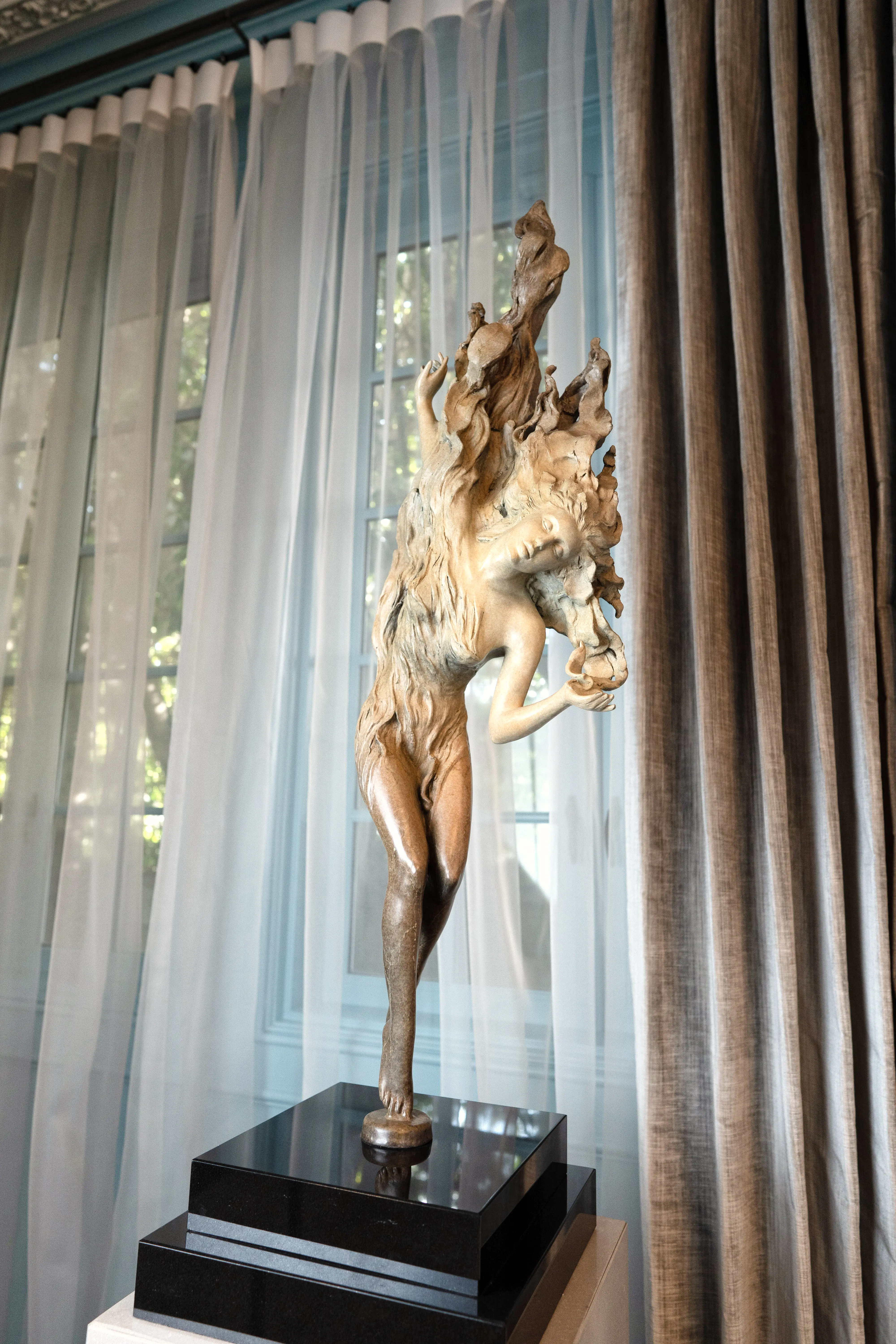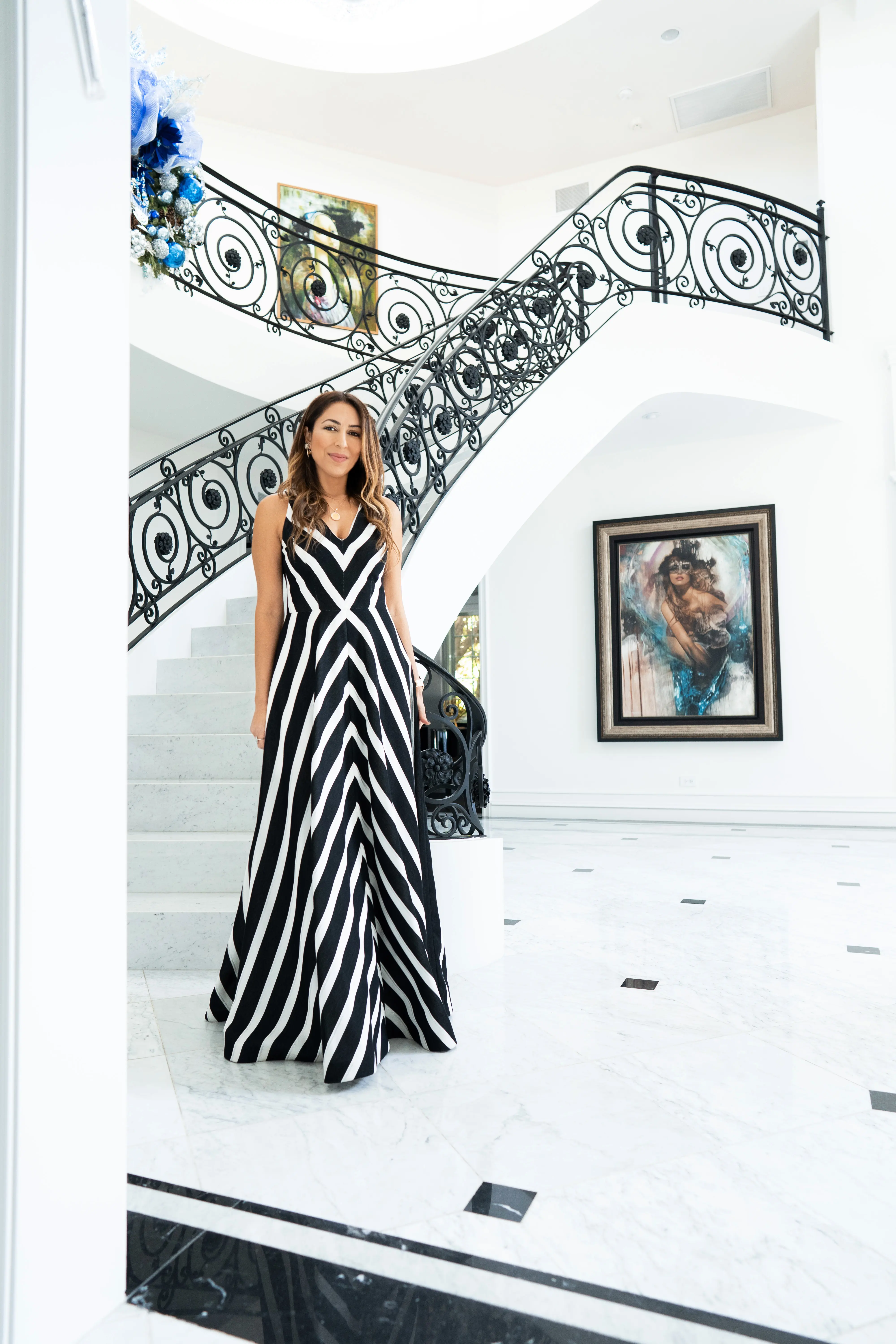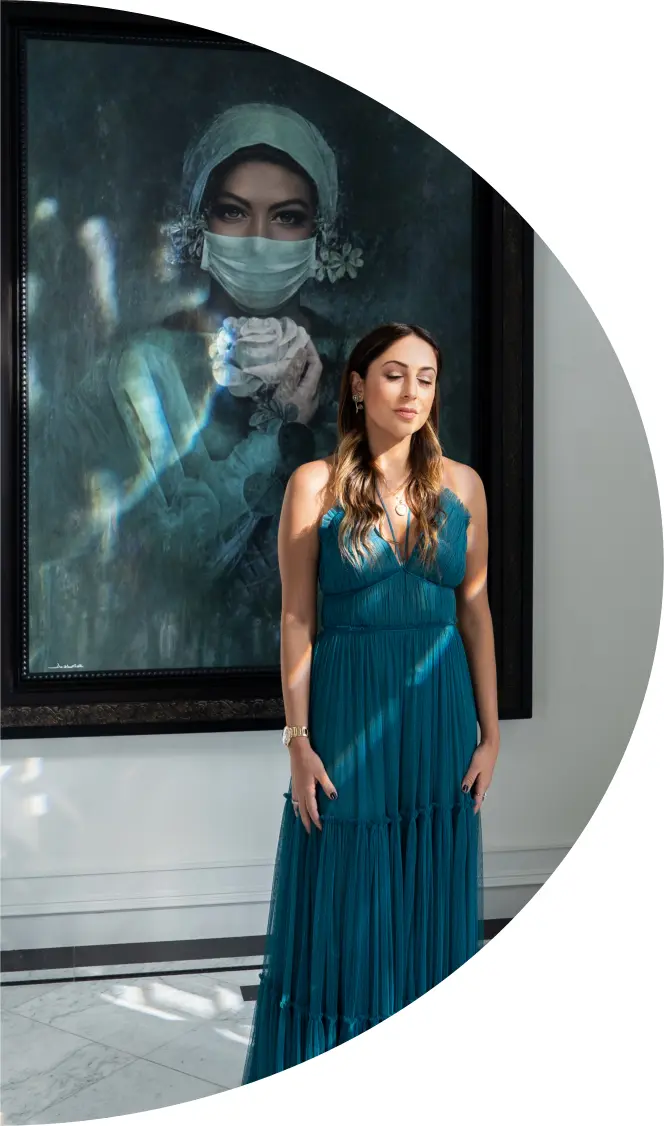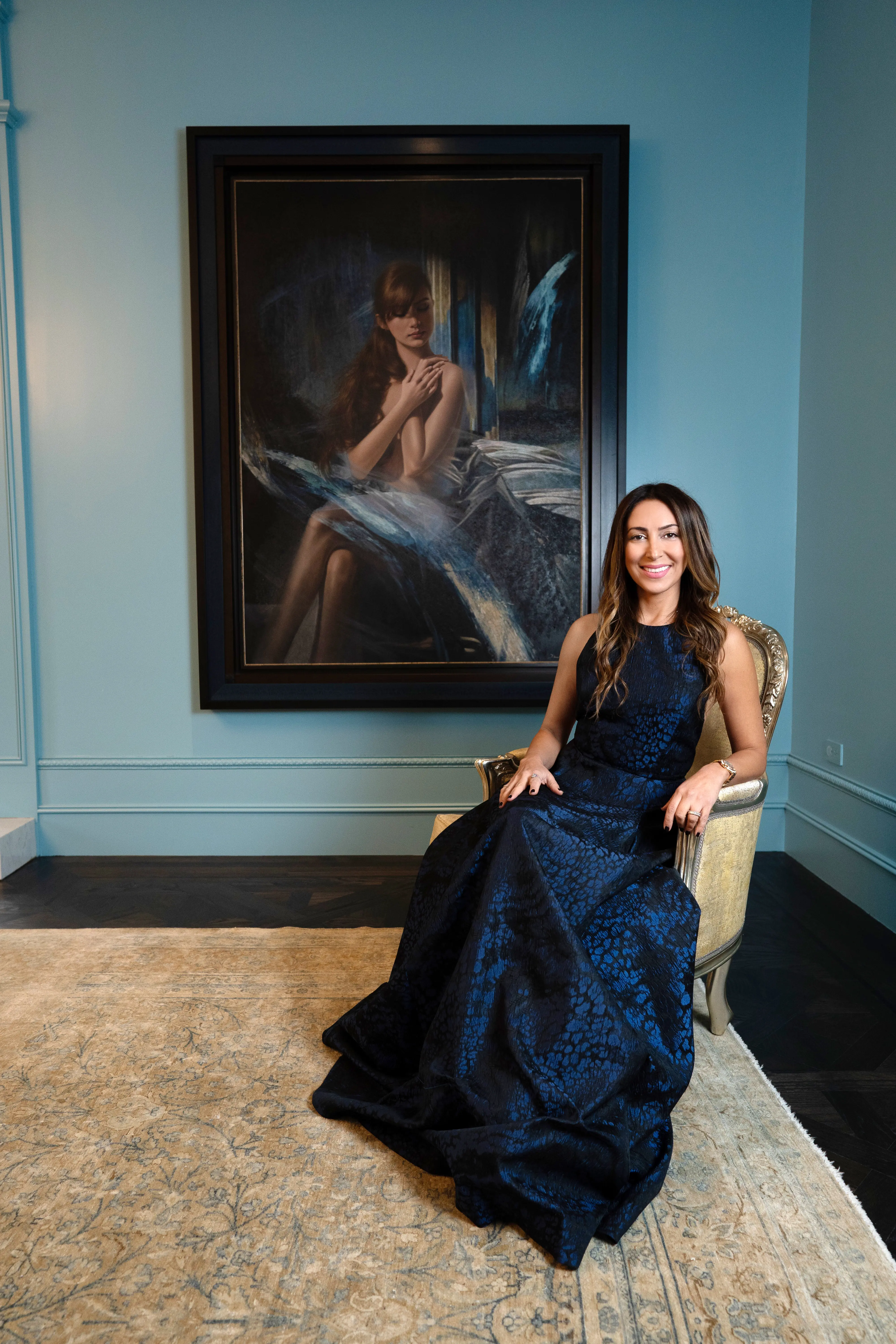

Written by Krista Kleiner
Photographs by JL Cederblom
Walking through the double glass doors of the Rastegar residence onto their stunning white marble floor, I felt instantaneously transported into a modern-day angelic escape. Surrounded by white walls and high ceilings, a grand staircase billowed down the side of their sparkling chandelier, giving the feel of an ornately regal museum. But even more captivating than the beautiful structure of their home were the striking pieces of art sprinkled throughout. With the clean backdrop surrounding, it was hard not to feel pulled into each piece.
Given the tough year our world has experienced, one struck me in particular; its placement by their front door also very telling. In soft shades of blue and teal, a woman with a mask held a white rose close to her heart; her eyes, soul piercing. It’s realistic yet enchanting essence gave a sense of calm…a sense of peace; a candle in the dark. It quickly reminded of the profound impact art can have telling stories that touch each of us in a uniquely special way.
The depth found within each painting and sculpture in the Rastegar home was very representative of Jasmine’s personal story. Through the struggles she and her family endured, blossomed meaningful beauty.


While her early life involved the harsh realities of escaping persecution, she successfully adjusted to her new life in a foreign country. Pivoting form her childhood dream of becoming a teacher, Jasmine pursued a career in law as she felt inspired to fight for justice. Juggling law school and a job in the evening, she got her degree from Abraham Lincoln University in downtown Los Angeles and dove straight into Worker’s Compensation Law. Years later, after meeting her husband and starting a family, she made the decision to pivot to the most important career of all – being a full-time mom. It was in this period that she felt she truly experienced the beauty of life.
Her belief that life isn’t just about what you can get but, but about what you can give to the world, led her and her husband to create the Tree of Love Foundation in 2020 after being involved in and donating to charities since the beginning of their relationship. Their goal in doing so was to have more of a direct impact and help people of the world from all races, religions, and ethnicities. Together, they deliver meals to about 120 elderly people a month through the Meals of Love Program of Chabad.org. They have also sponsored and founded the opening of three Hebrew day schools in the greater Los Angeles area. One of their main objectives includes supporting those who cannot afford their medical bills. Having helped numerous families, one of the most touching stories is the aid they provided to two sons whose father passed away to Covid-19 when they didn’t have the money for his services or to bury him.
Jasmine and her husband, Jacob Rastegar, have not only bonded through their philanthropic work, but through their collection of art. Join us as we get to know Jasmine Rastegar through the looking glass.
I understand that you came to the United States from Iran as a young child escaping persecution. Do you know much about what caused you and your family to move here?
There was a revolution in Iran. The Shaw was toppled, and the Ayatollahs came in and it became an Islamic republic. For some reason, they became unfair to us Jews not allowing us to own much or leave the country freely, slowly taking away our rights and liberties. So, my family decided to seek refuge and the U.S. accepted us.
I’m so glad that it worked out for you and your family. Do you remember or know if it was a difficult process?
It definitely was. We had to get fake passports with fictitious names through people who had the connections. Thank goodness my father had enough money for us to afford them so we could get out, especially because my brother was fourteen at the time and would have had to enlist in the army. Given that there was a war going on with Iraq as well, my parents didn’t want that to happen. So, we lowered his age in the passport so he could travel. They then interviewed us at the airport knowing that Jews would do this sort of thing trying to leave. It was a very nerve wrecking experience.
I can only imagine. How old were you and your siblings at the time?
I was four, my sister was a newborn, my other sister was five, my oldest sister was ten and my brother was fourteen.
What a fragile age to be going through all of this. Where did you first go once you left?
We had to go through an immigration process that required us to live in Switzerland for six months, then Italy for six months to wait for our papers before finally being able to come here.
So many hoops to jump through. People often underestimate how much people go through to come here.
You’re right. New language...new culture…new friends…new community…new everything.
When we finally got here, I was five and starting kindergarten. With the Iran hostage crisis going on, people were really standoffish. They had a hard time differentiating that the government is very different than the people of Iran. It was really tough.
I can only imagine. What I’ve found is that these sorts of challenges create a lot of depth and compassion within people because they know what it’s like to struggle.
That’s so true.

It really takes me into the art and gives me a sense of calm as if the world is innocent and there's no worries."
Were your parents also into collecting art?
Yes, my parents always had art around the house. I remember walking around looking at the pieces they had and becoming very intrigued as early as ten-years-old.
How has your taste changed over time?
I always liked scenery and portraits and then I started liking abstract art a lot, which has influenced some of my recent purchases.
What would you consider to be your current favorite artist and style?
I would say Sir Daniel Winn and his existential surrealism. He’s brilliant. The way he draws, his technique, everything.
Do you have a favorite piece?
Sir Daniel Winn’s Innocence.
What would you say attracts you to it?
The way he drew the woman makes me feel like I can feel her feelings. The background is very abstract while the person is very realistic. The way he draws the fingers and hands is incredible – it’s like an actual photograph. I also love how he brings surrealism to his art while still being photo realistic.
It’s a fascinating combination.
It really takes me into the art and gives me a sense of calm as if the world is innocent and there’s no worries.
How would you describe the rest of your art collection?
I’m also interested in horses and Royo draws horses beautifully, so we have a piece from him. He draws women beautifully too and actually drew a sketch portrait of me with one of my babies – it’s one of my favorites. The way Royo draws is really pretty because he can give you a sense of being in the picture.
I’m also a big fan of Ira Reines’ sculptures. We have quite a few of them. I think they’re brilliantly carved. When you look at them, you wouldn’t think that they are made of clay and bronze. They look like an actual body in that you can see every natural curve and crevice.
You have a great variety between your pieces. What guides you in making your selections?
All of this art is essentially an investment, but I don’t put up anything in my home that I don’t enjoy looking at. So my first guide is to ask, “Do I like to look at it? Does it move me in some way? “ I definitely don’t like anything sad or anything too surreal. More feel good.
It makes sense to keep the type of feel you’re bringing to your home in mind, especially having a family.
Exactly. Because art changes the vibe of your home. The second consideration I have is the value as the goal is for it to increase over the years.
What helps you decide what would make a good investment?
We have art advisors and do a lot of research on our own.
What is the largest increase in value that you have seen in one of your purchases?
Well, we just started collecting a little over a year ago, so it’s a little early to say, but we do expect to see big increases over the years.
You mentioned that you had children. How old are they?
8, 6 and 4.
Do you include them in the process and teach them along the way?
Very much so. My eldest actually has a favorite piece – The Nurse by Sir Daniel Winn. He’s very intuitive and asks a lot of questions and I love to answer them.
I understand that philanthropy is an important part of your life, as it is with mine, so I greatly appreciate that. What inspired you to focus on this?
I always believed in the concept of helping and being Jewish, charity is part of the teachings. I think it only makes sense to share wealth if you have it. People don’t need much to live a good life and I believe the more you share the better. I think it brings blessings upon your life and I find true happiness in sharing.
My husband and I factually founded our own nonprofit foundation this year, called the Tree of Love Foundation, where we basically help people with medical necessities but are unable to afford them.
That’s beautiful – and so relevant given what everyone’s going through with the pandemic.
Does your husband also have an interest in art and collecting it?
Yes, it’s an interest we both simultaneously started getting into.
Does he have similar taste as you?
He likes surrealism much more than I do. And he looooves Picasso. He’s one of his favorites. He likes abstract modern as well and of course he loves the art we have up.
Sounds like a good range between you two. How would you say collecting art has impacted your lives?
I feel very blessed to be able to bring the beauty into my own home and enjoy it on a daily basis. It constantly reminds me of how blessed I am. And it’s really nice to have, very calming, to have the art around and receive its energy.
Beautifully said. Do you have any advice to give someone who is new to collecting art?
I would say buy what you like, not what everyone else likes. Buy something that will be a good investment, but still something that you like because you’re going to be looking at it until it appreciates in value. You’re going to be stuck with it. So, you better like it. Better not bring a bad vibe into your home. (both laugh)
Wise words. -
